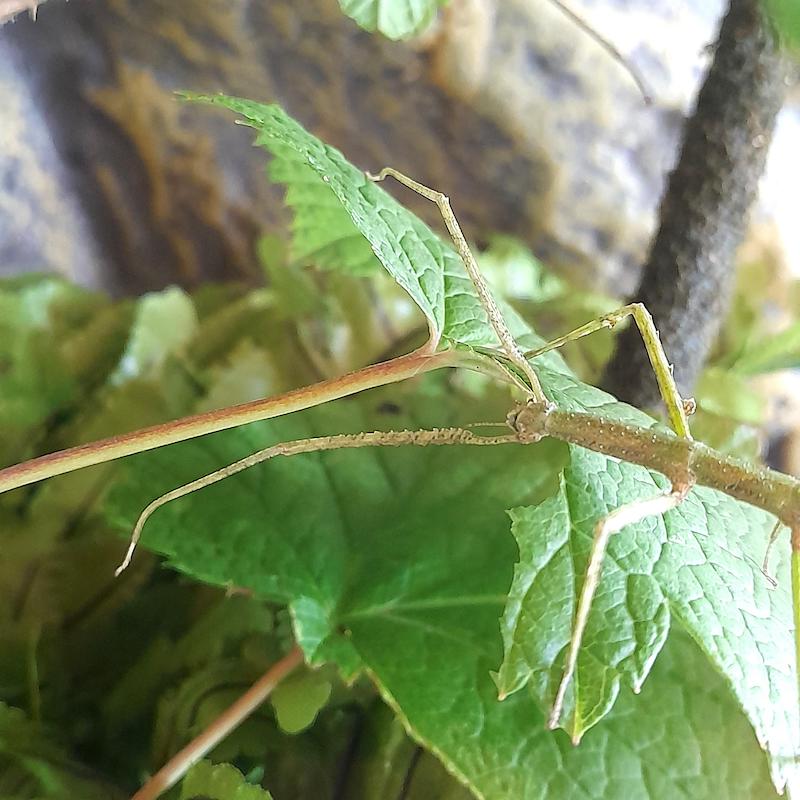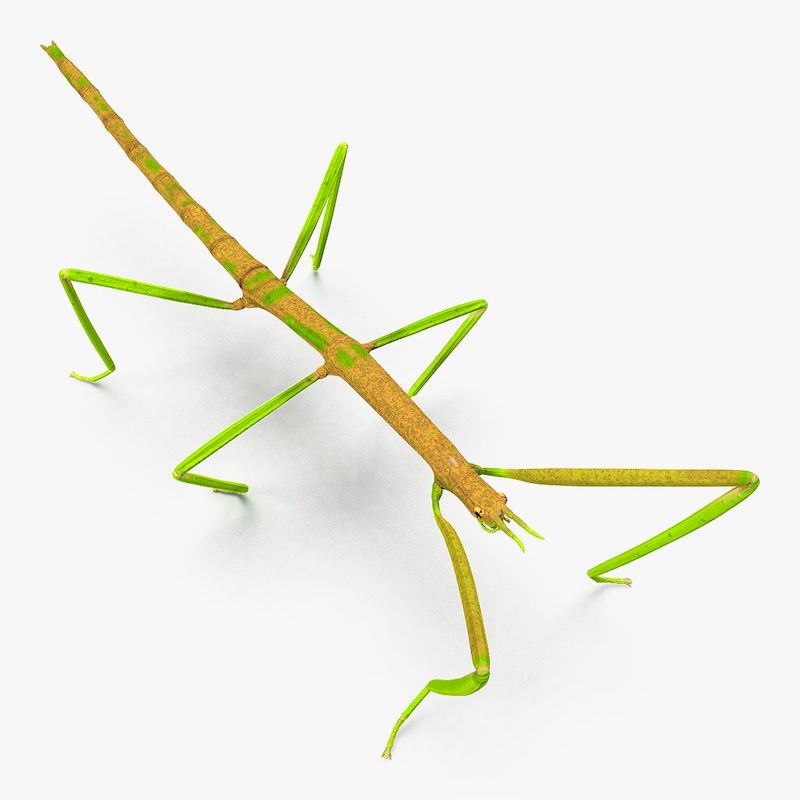Intriguing Camouflage Tactics
Walking stick insects, also known as phasmids, are masters at blending in. Their aim? To become invisible to predators. Walking stick animal have evolved to mimic their environment to an almost uncanny degree.
Physical Traits: Sticks, Leaves, or Twigs?
The walking stick animal comes with a body made to deceive. Many boast colors like brown, green, and grey. But it goes beyond hue. Their bodies mimic the shape of sticks, leaves, and twigs. Add to that their ability to stay motionless, and they nearly vanish in their habitat. So, when a predator glances their way, it sees nothing unusual – just another part of the plant world.
Active Defenses: Smells, Colors, and Sudden Drops
When stealth isn’t enough, walking sticks have backup plans. Some can secrete foul odors, discouraging would-be attackers. Others reveal vivid wing colors only to hide them swiftly, leaving predators confused. If danger looms, these insects might also perform a sudden drop to the ground. There, motionless, they’re just another dropped twig. Crafty, right? Their tactics are about surprise, offense, and a quick return to hiding.
Habitats: Forests, Woodlands and Beyond
Walking stick insects are habitat generalists. They thrive in diverse environments from tropical forests to temperate woodlands.
Tropical Treasures and Temperate Dwellers
In tropical rainforests, walking stick animals flourish. They blend with lush foliage, making them hard to spot. Many species also live in temperate regions. There, they adapt to less dense vegetation and seasonal changes.
The Art of Motionless Disguise
Whether tropical or temperate, walking sticks master stillness. They pose motionless for hours, mimicking twigs swayed by breezes. Predators look but often see nothing, as walking sticks merge with their surroundings.
The Nocturnal Lifestyle
Walking stick animals lead a predominantly nocturnal existence. They have adapted this lifestyle largely as a means to avoid predators, which are more active during the day.
Avoiding Predators: From Birds to Bats
Nighttime for walking stick insects is about survival. By being active in the dark, they dodge many predators like birds and primates who hunt by daylight. Despite this, nocturnal threats remain. Bats in particular, with their echolocation, can detect and dine on these insects. Yet, the walking stick’s nightly habits substantially lower their risk of becoming a meal.
Plant-Based Diet and Its Ecological Impact
Walking sticks are herbivores, feasting on leaves under the cloak of night. This plant-based diet reflects on the ecosystem, as their droppings enrich the soil. In addition, by consuming foliage, they prompt the growth of new plant life, playing a subtle but vital role in the health of their habitats.
Reproduction: A Tale of Parthenogenesis and Ingenuity
Walking stick animals exhibit a remarkable mode of reproduction known as parthenogenesis. This impressive strategy allows these insects to thrive, even in conditions where males are scarce.
Female-Only Lineage: No Males Needed
In a striking departure from the norm, female walking stick insects can reproduce without males. Through parthenogenesis, unfertilized eggs develop into new females. This ability ensures the survival of their species even when mates are not present.
Egg Laying Strategies: On the Ground and Beyond
The ingenuity of walking stick animals extends to their egg laying techniques. Females disperse eggs in various subtle ways to avoid detection by predators. Some tactics include dropping them to the forest floor, mimicking the appearance of seeds. Others might tuck eggs away in the soil, plant crevices, or stick them under leaves. These strategies help protect the next generation from hungry eyes.
Conservation Efforts for Walking Stick Insects
While walking stick animals are remarkable for their adaptations, they face serious threats to their survival.
Challenges: Human Encroachment and Pesticides
Walking sticks are losing their homes due to human activities. Forests are cut down for farming and cities. Pesticides used in these areas can also kill them. This makes it hard for them to live and breed safely.
Rearing Programs: Success Stories and Future Plans
Good news comes from rearing programs. Zoos and scientists are raising walking sticks to save them. In places like the Melbourne Zoo, walking sticks are bred in safety. They learn how to take care of them and even create new homes. The goal is to have more of them in nature again. These plans give us hope for walking sticks’ future.
Species Spotlight: North American Walking Sticks
Walking stick animals, known for their superb mimicry, are quite diverse. In North America, certain species stand out for their unique features.
Identifying Common Species and Their Attributes
Two noteworthy species in North America catch the eyes of enthusiasts. The northern walkingstick (‘Diapheromera femorata’) is one. It showcases a slender body that can be up to 3? inches long. Females often have a greenish brown tint, blending seamlessly with the foliage. Giant walkingsticks (‘Megaphasma denticrus’), on the other hand, impress with their size, being the longest at up to 7 inches. They have spiny legs and females are larger than males. Both species are wingless, adding to their stick-like facade.
Attributes that aide these insects include their elongated bodies and swaying movements. This behavior resembles twigs swaying in the breeze, enhancing their camouflage. Walking stick animals in North America also vary in color. They range from brown to green, matching the trees they live upon.
Conservation Status and Distribution
The presence of walking stick animals spans throughout the continent. However, certain areas like the southernmost states harbor most species. Globally, thousands of species exist, but few make North America their home.
Despite their proficiency at hiding, these walking sticks face challenges. Loss of habitat and pesticide use threaten their survival. Yet, they’re still common in suitable environments. Strides in conservation and education raise awareness of their plight. Their ‘phantom-like’ existence makes them a natural wonder in the world of insects.
Efforts to study and protect them continue. In some regions, they are monitored to prevent overpopulation and potential defoliation of trees. Walking stick animals, despite their subtle existence, play a significant role in the ecological balance.
Behavioral Patterns and Life Cycle
Walking stick animals have intriguing lifestyles woven into the rhythm of nature. Their life cycle adapts to seasons and predators, making their survival a delicate art.
Overwintering: Survival Through the Cold
Surviving winter is tough for any creature, and walking stick animals have their method. They drop eggs into leaf litter before dying off in the freeze. These eggs rest, hidden and insulated, until spring, when new life hatches. This overwintering means even in harsh climates, the walking stick lineage persists.
Growth and Development: From Nymph to Adult
The life of a walking stick insect is a journey from a tiny nymph to a full-sized adult. After hatching, they begin a series of molts, shedding their exoskeletons multiple times. Each stage, or instar, brings them closer to adulthood. Their growth is steady and secret, hidden away in the foliage. Only after their final molt do they emerge as adults, ready to blend in, and continue the cycle. Their transformation, though subtle, is a critical phase in their solitary life.
The Role of Walking Stick Insects in Ecosystems
Walking stick insects, by their very nature, play a vital role in their ecosystems.
Impact on Vegetation
Their plant-based diet involves munching on leaves from various trees and shrubs. This act, while seemingly minor, influences plant health and growth. When walking stick animals feed on foliage, they help in natural pruning. This leads to more vigorous plant growth and diversification. In forests, this could mean healthier trees and a more varied underbrush. Despite being herbivores, the walking stick animal aids in maintaining plant diversity.
Predation and the Food Chain
Predators play a crucial part in the life of walking stick animal. Birds and small mammals often hunt these camouflaged creatures. Moreover, even though they are experts at hiding, they are an important food source for these predators. By taking part in this natural cycle, they help balance their local environments. The presence of walking stick insects indicates a vibrant, functioning ecosystem where predator and prey dynamics are maintained. These insects contribute to the complexity of food webs, supporting a diverse array of wildlife.



